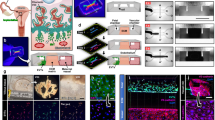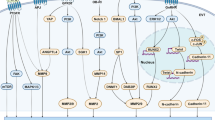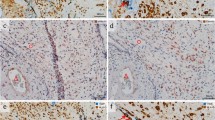Abstract.
During intrauterine human placentation, extravillous trophoblast invades uterine tissues starting with proliferating stem cells at the basement membrane of anchoring villi. Transition to the postproliferative invasive phenotype takes place several cell layers distant. Here we show that in intrauterine pregnancies invasive trophoblast comprises three cellular phenotypes: a. Small spindle-shaped trophoblast cells are found along the whole invasive pathway throughout pregnancy. They are embedded in little heterogeneous extracellular matrix but expose only fibronectin receptors (integrins α5β1, αvβ3/5), resulting in a partial integrin-matrix mismatch. b. Large polygonal trophoblast cells are rare in early pregnancy but increase in number towards term. They secrete ample heterogeneous extracellular matrix and expose integrins specifically matching the opposing matrix molecules (integrins α6β4, α5β1). c. Multinucleated giant cells in all stages of pregnancy form a kind of peripheral shell of trophoblast.In contrast to intrauterine pregnancies, in viable tubal pregnancies, Mib-1 expression indicating proliferation, extends deeply into the invasive pathway. Trophoblast cells of the invasive pathway mostly belong to the small spindle-shaped phenotype and secrete little extracellular matrix, mainly fibronectins. At the transition to the second cellular layer of cell columns expression of integrin α6β4 switches to expression of α5β1 and αvβ3/5. Viable tubal pregnancies are characterised by a broad overlap of proliferative with invasive phenotype as well as a general integrin-matrix mismatch. The differences in proliferation patterns, cellular phenotype and matrix-integrin co-localisation may well explain the increase of invasiveness of normal extravillous trophoblast from term intrauterine via early intrauterine to viable tubal pregnancies.
Similar content being viewed by others
Author information
Authors and Affiliations
Additional information
Electronic Publication
Rights and permissions
About this article
Cite this article
Kemp, B., Kertschanska, S., Kadyrov, M. et al. Invasive depth of extravillous trophoblast correlates with cellular phenotype: a comparison of intra- and extrauterine implantation sites. Histochem Cell Biol 117, 401–414 (2002). https://doi.org/10.1007/s00418-002-0396-0
Accepted:
Published:
Issue Date:
DOI: https://doi.org/10.1007/s00418-002-0396-0




